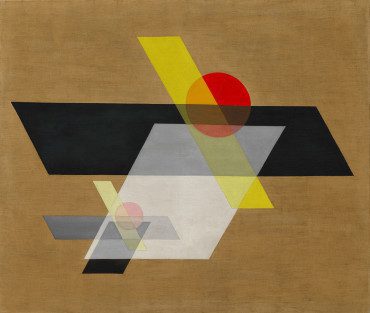 |
| László Moholy-Nagy A II (Construction A II), 1924 Oil and graphite on canvas, 115.8 × 136.5 cm Solomon R. Guggenheim Museum, New York, Solomon R. Guggenheim Founding Collection 43.900 © 2016 Hattula Moholy-Nagy/VG Bild-Kunst, Bonn/Artists Rights Society (ARS), New York |
Exhibition: Moholy-Nagy: Future Present
Venue: Solomon R. Guggenheim Museum, 1071 Fifth Avenue, New York
Location: Full rotunda
Dates: May 27–September 7, 2016
Media Preview: Thursday, May 26, 2016, 10 am–1 pm
(NEW YORK, NY, May 26, 2015)— From May 27
to September 7, 2016, the Solomon R. Guggenheim Museum will present the
first comprehensive retrospective in the United States in nearly fifty
years of the work of pioneering artist and educator László Moholy-Nagy
(1895–1946). Organized by the Solomon R. Guggenheim Foundation, the Art
Institute of Chicago, and the Los Angeles County Museum of Art, Moholy-Nagy: Future Present examines
the full career of the utopian modernist who believed in the potential
of art as a vehicle for social transformation, working hand in hand with
technology. Despite Moholy-Nagy’s prominence and the visibility of his
work during his lifetime, few exhibitions have conveyed the experimental
nature of his work, his enthusiasm for industrial materials, and his
radical innovations with movement and light. This long overdue
presentation, which encompasses his multidisciplinary methodology,
brings together more than 300 works drawn from public and private
collections across Europe and the United States, some of which have
never before been shown publicly in this country. After its debut
presentation in New York, the exhibition will travel to the Art
Institute of Chicago (October 2, 2016–January 3, 2017) and the Los
Angeles County Museum of Art (February 12–June 18, 2017).
Moholy-Nagy: Future Present is
co-organized by Carol S. Eliel, Curator of Modern Art, Los Angeles
County Museum of Art; Karole P. B. Vail, Curator, Solomon R. Guggenheim
Museum; and Matthew S. Witkovsky, Richard and Ellen Sandor Chair and
Curator, Department of Photography, Art Institute of Chicago. The
Guggenheim presentation is organized by Vail, with the assistance of
Ylinka Barotto, Curatorial Assistant, and Danielle Toubrinet, Exhibition
Assistant.
The New York presentation of Moholy-Nagy: Future Present
is made possible by Lavazza. Funding is generously provided by David
Berg Foundation, Ministry of Foreign Affairs and Trade of Hungary, The
Hilla von Rebay Foundation, William Talbott Hillman Foundation, Robert
Lehman Foundation, and Sotheby’s. The Leadership Committee for the
exhibition, chaired by Peter and Dede Lawson-Johnston, is gratefully
acknowledged for its support, with special thanks to Stefan Edlis and
Gael Neeson, Rachel and Jean-Pierre Lehmann, Rowland Weinstein,
Fundación Almine y Bernard Ruiz-Picasso para el Arte, and Achim Moeller.
Additional funding is also provided by the National Endowment for the
Arts.
Moholy-Nagy: Future Present provides an
opportunity to examine the full career of this influential Bauhaus
teacher, founder of Chicago’s Institute of Design, and versatile artist
who paved the way for increasingly interdisciplinary and multimedia work
and practice. Among his radical innovations were his experiments with
cameraless photographs (which he dubbed “photograms”); use of industrial
materials in painting and sculpture that was unconventional for his
time; researching with light, transparency, and movement; his work at
the forefront of abstraction; and his ability to move fluidly between
the fine and applied arts. The exhibition is presented chronologically
up the Guggenheim’s rotunda and features collages, drawings, ephemera,
films, paintings, photograms, photographs, photomontages, and
sculptures. The exception to the sequential order is Room of the Present (Raum der Gegenwart)
in the High Gallery, a contemporary fabrication of a space originally
conceived by Moholy-Nagy in 1930 but never realized in his lifetime.
Constructed by designers Kai-Uwe Hemken and Jakob Gebert, the
large-scale work contains photographic reproductions, films, slides,
documents, and replicas of architecture, theater, and industrial design,
including a 2006 replica of his kinetic Light Prop for an Electric Stage (Lichtrequisit einer elektrischen Bühne, 1930). Room of the Present
illustrates the artist’s belief in the power of images and his approach
to the various means with which to view them—a highly relevant paradigm
in today’s constantly shifting and evolving technological world. Room of the Present
will be on display at all three exhibition venues and for the first
time in the United States. The Guggenheim installation is designed by
Kelly Cullinan, Senior Exhibition Designer, and is inspired by
Moholy-Nagy’s texts on space and his concept of a “spatial kaleidoscope”
as applied to the experience of walking up the ramps.
Born in 1895 in Austria-Hungary (now southern
Hungary), Moholy-Nagy moved to Vienna briefly and then to Berlin in
1920, where he encountered Dada artists, whose distinctive visual
attributes of the urban industrial landscape had already entered his
work. He was also influenced by the Constructivists, and exhibited work
on several occasions at Berlin’s Der Sturm gallery. During this time,
Moholy-Nagy experimented with metal constructions, photograms, and
enamel paintings. At the same moment, in his ongoing quest to depict
light and transparency, he painted abstract canvases composed of
floating geometric shapes. While teaching at the Bauhaus in Weimar and
then Dessau, he and Walter Gropius pioneered the Bauhaus Books series,
which advanced Moholy-Nagy’s belief that arts education and
administration went hand in hand with the practice of art making. Around
this period, the artist became temporarily disenchanted with the
limitations of traditional painting. Photography took on greater
importance for him, and he described the photogram as “a bridge leading
to new visual creation for which canvas, paint-brush and pigment cannot
serve.” He fashioned photomontages by combining photographs (usually
found) and newspaper images into absurd, satirical, or fantastical
narratives. When he moved back to Berlin in 1928, he enjoyed success as a
commercial artist, exhibition and stage designer, and typographer,
examples of which will be on display in Moholy-Nagy: Future Present.
Adolf Hitler’s rise to power made life increasingly difficult for the
avant-garde in Germany; thus, in 1934 Moholy-Nagy moved with his family
to the Netherlands and then to London. Once he moved to Chicago in 1937,
he never returned to Europe.
Moholy-Nagy immigrated to Chicago to become
founding director of the New Bauhaus, known today as the Institute of
Design at the Illinois Institute of Technology. He also made some of his
most original and experimental work during this time, pursuing his
longtime fascination with light, shadow, transparency, and motion. He
continued to make photograms, created his Space Modulators
(hybrids of painting and sculpture made from Plexiglas), and pioneered
35 mm color slide photography, shown as projections in the exhibition.
He gave his full attention to American exhibition venues before his
untimely death of leukemia in 1946, showing nearly three dozen times
across the United States—including in four solo shows.
Moholy-Nagy was a central figure in the history
of the Guggenheim Museum. His work was included in the museum’s founding
collection, and he held a special place at the Museum of Non-Objective
Painting, the forerunner of the Guggenheim Museum. He was among the
first artists director Hilla Rebay exhibited and collected in depth, and
the museum presented a memorial exhibition shortly after his death. Moholy-Nagy: Future Present
highlights the artist’s interdisciplinary and investigative approach,
migrating from the school to the museum or gallery space, consistently
pushing toward the Gesamtwerk, the total work, which he sought to achieve throughout his lifetime.
Exhibition Catalogue
Moholy-Nagy: Future Present is accompanied by an extensively
researched catalogue examining the work of the pioneering artist.
Featuring more than 300 works illustrated in color, it is the most
comprehensive English-language book on Moholy-Nagy in over thirty years
and offers an integrated presentation of his works across mediums,
including painting, sculpture, photography, graphic design, and film.
The exhibition curators and other scholars provide new insights into
Moholy-Nagy’s methods and his influence. Essays examine
the confluence of writing, arts administration, and art making in the
artist’s practice; his use of materials, incorporating intensive
conservation research and analysis; and his impact on redefining the
role of the artist in society. Particular emphasis is given to his
American years and his leadership of the Institute of Design in Chicago.
The catalogue will be available for purchase at guggenheim.org/store (hardcover: $65, softcover: $45).
Education and Public Programs
A range of programs featuring film, music, and explorations into
László Moholy-Nagy’s resonance today is offered in conjunction with Moholy-Nagy: Future Present. Highlights are listed below, with full information and tickets available at guggenheim.org/calendar.
Film
Films to Come: Moholy-Nagy and the Moving Image
Fridays–Saturdays, June 3–August 26, 11 am
This film program includes documentaries about László Moholy-Nagy,
Bauhaus films, selections of abstract cinema, and works by contemporary
filmmakers inspired by the artist.
Panel
Moholy-Nagy: Art for a New Century
Wednesday, June 22, 6:30 pm
Bringing together scholars, curators, and artists, this program explores
how László Moholy-Nagy’s experimental and multifaceted practice
resonates today more than ever. Presentations by Oliver Botar
(University of Manitoba), Carol S. Eliel (Los Angeles County Museum of
Art co-organizing curator), and artist Barbara Kasten are followed by a
panel discussion. Moderated by Karole P. B. Vail, Guggenheim
co-organizing curator. $15, $10 members, free for students with RSVP.
For Middle Schoolers
Game Design Workshop
Wednesday, June 29, 1–5 pm
Grades 5–8. Just as László Moholy-Nagy was challenged to create dynamic
compositions through various materials and new technologies,
participants will design games through hands-on activities and by using
Gamestar Mechanic, a video game creation tool. Students will also learn
how to submit their games as part of the 2016 National STEM Video Game
Challenge. Free with RSVP. Created in collaboration with the 2016 STEM
Challenge, The Institute of Museum and Library Services, The Joan Ganz
Cooney Center, and E-Line Media.
Performance
Moholy-Nagy: Optical Sound
Thursday, July 21, 7 pm
In response to what László Moholy-Nagy referred to as an “opto-acoustic
alphabet,” this program highlights the fusion of modulated sound and
light. A large-scale multichannel presentation of innovative Hungarian
electronic music from the 1970s is followed by a performance by a
contemporary practitioner of intermedia work that exemplifies
Moholy-Nagy’s dream of a “groove script.” $30, $20 members, $15
students.
Tours
Curator’s Eye
Friday, June 3, 12 pm
Karole P. B. Vail, Curator, Solomon R. Guggenheim Museum
Conservator’s Eye
Friday, July 29, 12 pm
Julie Barten, Senior Conservator, Collections and Exhibitions, Solomon
R. Guggenheim Museum, and contributor to the exhibition catalogue
About the Solomon R. Guggenheim Museum
Founded in 1937, the Solomon R. Guggenheim Foundation is dedicated
to promoting the understanding and appreciation of art, primarily of the
modern and contemporary periods, through exhibitions, education
programs, research initiatives, and publications. The Guggenheim network
that began in the 1970s when the Solomon R. Guggenheim Museum, New
York, was joined by the Peggy Guggenheim Collection, Venice, has since
expanded to include the Guggenheim Museum Bilbao (opened 1997) and the
Guggenheim Abu Dhabi (currently in development). The Guggenheim
Foundation continues to forge international collaborations that
celebrate contemporary art, architecture, and design within and beyond
the walls of the museum, including the Guggenheim UBS MAP Global Art
Initiative and The Robert H. N. Ho Family Foundation Chinese Art
Initiative. More information about the Solomon R. Guggenheim Foundation
can be found at guggenheim.org.
VISITOR INFORMATION
Admission: Adults $25, students/seniors (65+)
$18, members and children under 12 free. The Guggenheim’s free app,
available with admission or by download to personal devices, offers an
enhanced visitor experience. The app features content on special
exhibitions as well as access to more than 1,500 works in the
Guggenheim’s permanent collection. Additionally, information about the
museum’s landmark building is available in English, French, German, Italian, and Spanish. Verbal Description guides for select exhibitions are also included for visitors who are blind or have low vision. The Guggenheim app is supported by Bloomberg Philanthropies.
Museum Hours: Sun–Wed, 10 am–5:45 pm; Fri,
10 am–5:45 pm; Sat, 10 am–7:45 pm; closed Thurs. On Saturdays,
beginning at 5:45 pm, the museum hosts Pay What You Wish. For general
information, call  212 423 3500 or visit the museum online at: guggenheim.org
212 423 3500 or visit the museum online at: guggenheim.org
guggenheim.org/social#MoholyNagy


